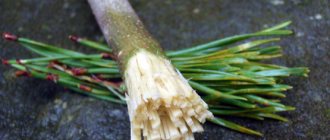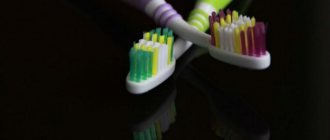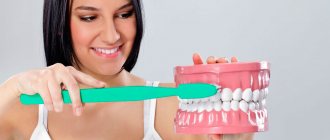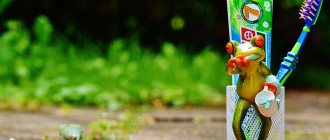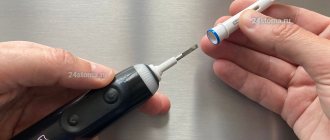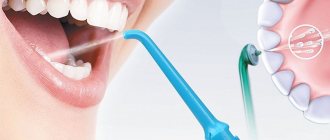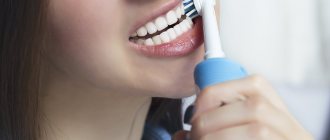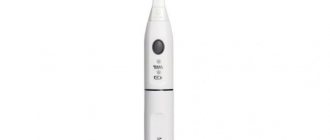Toothpaste is a mandatory attribute of personal hygiene and it is difficult to imagine a modern person who can do without oral care for a long time. Toothpaste not only eliminates bad breath, but is also a good preventive measure for quite serious diseases of the teeth and gums.
However, there may be situations when toothpaste may not be at hand, or its use for some reason is not advisable. In such situations, the question is quite natural: what can replace toothpaste ? The alternative option should be as safe as possible and at the same time quite effective. In order to decide what to replace toothpaste with , you need to pay attention to its composition.
Why do you need to brush your teeth?
Prevention of dental diseases and care include daily brushing of teeth with a brush and toothpaste 2 times a day. If you do this rarely, plaque builds up. And when care is performed more often, there is a chance of damage to the enamel.
If regular cleaning is not done, then a problem appears in the form of bad breath, plaque and yellowish discoloration, and dental ailments. Dentists advise brushing your teeth before breakfast, not after. The reason is the presence of a biofilm of plaque and bacteria that remains on the teeth after an overnight rest.
What is professional teeth cleaning?
This is the mechanical removal of any plaque from all surfaces of the teeth. Hygiene does not in any way change the color of the enamel itself, but can return it to its natural whiteness. There are two main methods of professional cleaning:
- Air Flow - supplying a thin stream of water-soda solution under pressure. Removes soft plaque, there are almost no contraindications.
- Ultrasound cleaning is the effect of ultrasound on tartar. The sound seems to “split” it without causing harm to the enamel. If dental structures are installed, cleaning is contraindicated - ultrasound can damage the adhesive connections. But it is easy to carry out partially, in certain areas of the dentition.
These two types of cleansing are not alternatives, as is sometimes suggested in VHI programs. They are intended for different purposes and are performed sequentially in one appointment.
Here are 5 reasons why ultrasonic cleaning and Air Flow are indispensable procedures for everyone who cares about their teeth.
Air Flow does not lighten enamel, but completely cleans teeth
Siwak tree sticks
This is another answer to the question of how to brush your teeth if you don’t have a toothbrush. Siwak tree sticks are sold online in vacuum packaging, which includes several pieces. In ancient times they were used for cleaning. One stick can be used for a month.
You just need to follow the general storage rules: keep the box of sticks open to prevent mold and store in a non-humid place. How to brush your teeth without a toothbrush using this device? The procedure is simple: you just need to chew it, having cleared the bark in advance. In “field conditions” you can find a 15-20 cm stick, remove the top skin, after which it is ready for use instead of a brush.
Use dental floss and mouthwash
Dmytro Panchenko/Thinkstock
If you forgot your toothbrush and don’t have any toothpaste, but have dental floss and mouthwash , you can brush your teeth no worse than at home with your usual hygiene products.
1. Use dental floss to remove hard pieces of food stuck between your teeth;
2. Rinse your mouth thoroughly with water;
3. Finally, rinse your mouth with mouthwash to kill any remaining bacteria.
Yes, of course, we understand that the likelihood that you forgot your toothbrush, but put dental floss and mouthwash in your bag, is very small, but this is perhaps the best option (we recommend always having this “gentleman’s” kit with you) in his bag).
Finger
How can you brush your teeth if you don’t have a brush? If there is nothing, you can use your own finger. First you need to wash your hands. The index finger is used to brush, making circular movements over the teeth and gums. If there is a paste, it is first applied to the finger. You should thoroughly rinse your finger when moving from the lower to the upper teeth.
Use a washcloth, napkins or paper towels
earthsider.com
see also
5 unexpected uses of hydrogen peroxide: life hack
A life hack with a washcloth that you can use to brush your teeth may sound quite strange and stupid at first glance, but don’t rush to conclusions!
Experienced business travelers say that this option is suitable as a last resort. The rough texture will remove more plaque than if you simply rubbed your teeth with toothpaste on it.
This method of cleaning teeth can also be done using a paper towel.
1. First, rinse your mouth with water to remove as much food debris as possible.
2. Next, wrap a cloth or paper towel around your index finger and apply toothpaste if you have it (though the method works even if you don't have any on you).
3. Wipe all your teeth and gums in this way.
4. Rinse your mouth when finished and finish with mouthwash (if you have one).
PS Use only a clean washcloth or other lint-free cloth.
Irrigator
This is a special device that helps remove plaque and food debris using water or medicine. According to dentists, using an irrigator instead of floss and brush is much more effective for the entire oral cavity.
The irrigator (aerator) includes a compressor or hydraulic pump, a water container, a set of different nozzles and a comfortable handle. Water or medicinal liquid is supplied into the mouth by a compressor through a nozzle under pressure. This cleaning removes food debris and plaque, improves blood circulation in the gums, and makes them stronger.
The attachments include classic, periodontal, orthodontic, nasal, with a mini-turbine or a spoon for cleaning the tongue. Irrigators can be used for prevention or therapy if a special solution can be used instead of water. There are devices where water is supplied by pulsation or air microbubbles. The device can be used in any environment, it is only important that there is a charged battery or power supply.
Chew gum (sugar-free)
recyclingnation.com
Just like chewing vegetables, chewing gum can be a great way to remove plaque when brushing is not an option.
Chewing gum can dislodge any food particles remaining in the teeth and produce saliva, which is a natural disinfectant for rinsing the mouth and killing bacteria.
It is recommended to avoid sweets and use sugar-free chewing gum .
Useful tips
There are recommendations that allow you to brush your teeth efficiently:
- You should not start cleaning earlier than 15 minutes after eating. This increases the effectiveness of the paste. After eating some food, for example, spicy or sour, the procedure should be performed no earlier than half an hour later.
- It is advisable to brush your teeth after breakfast and before going to bed at night. Dentists consider this time to be the most suitable for these procedures. Brushing before bed prevents the growth of harmful microorganisms in the mouth, since the salivary glands function weakly at night.
- Cleaning should be done for at least 3 minutes, but do not overdo it. Cleaning for too long (more than 10 minutes) can lead to problems with the enamel, especially when using a paste with a high fluoride content.
- During the day, you need to use toothpicks to remove food particles in the interdental space. The procedure must be performed carefully to prevent injury to the gums and infection in the wound.
- You should independently identify problem areas and give them due attention. For effective care, it is advisable to consult a dentist.
- You should pay attention to the gums, since often beneficial effects for the teeth lead to damage to other areas of the cavity. Bleeding gums can be a symptom of gingivitis.
- Using mouthwashes is not necessary, but it provides a comprehensive approach to prevention.
Additional methods of oral hygiene
There are a number of products on the dental market that help maintain oral hygiene. They can also be useful for cleaning teeth on an occasional basis.
Rinse aids
Mouth rinses are not intended to fully clean teeth . They only kill harmful bacteria located in the oral cavity and prevent the formation of plaque.
Without brushing your teeth, they will not completely remove plaque; your teeth will only be partially cleaned; however, in the absence of other options, this situation is not so bad.
Rinse for cleaning for approximately 1 minute.
Dental floss
Dental floss is unlikely to clean all of your tooth enamel. With its help, you can only complement the cleaning process by eliminating plaque in hard-to-reach places , but cannot replace it in any way.
Without toothpaste and a brush, dental floss will not be suitable for cleaning enamel.
Chewing gum
Chewing gum can partially remove plaque from tooth enamel and freshen your breath well .
For your information! It is recommended to use it after meals, as due to its texture, it effectively cleanses the oral cavity of bacteria remaining after a meal.
It can replace your morning wash, but you shouldn’t expect the effect of toothpaste and brush.
Green tea
To clean your teeth, it is enough to drink green tea, but for greater effect it is recommended to rinse your mouth with it. The herbal drink removes plaque well and has an anti-inflammatory effect .
Fruits and vegetables that clean your teeth
Fibrous fruits and vegetables can help fight plaque because they contain acids and vitamins that help whiten tooth enamel. They help fight tooth decay .
Fruits and vegetables that clean your teeth:
- apples;
- carrot;
- celery.
What to replace pasta with?
There are situations where there is not only a lack of a brush, but also a lack of toothpaste. What to do in this case? You can find an alternative to pasta at home. The following tools can be used instead:
- Tea tree oil. It is rubbed into the enamel. The product has an excellent whitening effect that occurs naturally. Moreover, the oil does not have a negative effect or destruction properties. It also strengthens enamel, protects against inflammation and disinfects the oral cavity. But you need to take into account the minus of the oil - the presence of a pungent odor and bitter taste.
- Salt. The product is effective for cleaning teeth, as it has an antiseptic, anti-inflammatory and regenerating effect. Salt easily gets rid of bad breath. It is very easy to use: dip the brush in water, apply salt to it, and clean it without sudden movements or strong pressure.
- Baking soda. The product perfectly cleanses enamel, but it should only be used in rare cases, otherwise it damages the teeth. It is advisable to perform such procedures no more than once a week.
- Powdered milk. The product is also ideal for those who have bleeding gums or tartar. It copes well with unpleasant odors, but the effect is not long lasting. Powdered milk should be used as a powder.
- Clay powder. Your teeth will be noticeably whiter after using it. White clay needs to be dried and ground into powder. Then a couple of drops of ether are added. There is ready-made powder in stores.
- Activated carbon. With it, teeth become whiter, pigment spots are also eliminated, the microflora of the oral cavity is normalized and toxins are eliminated. Charcoal gets rid of bad breath. But you shouldn’t use it constantly, because it injures the enamel.
- Hydrogen peroxide. The solution is considered an analogue of professional cleaning. It is not advisable to use it more than once a week. Hydrogen peroxide gets rid of yellowness, eliminates unpleasant odors, and also provides an antiseptic effect.
Therefore, there is nothing to worry about if you don’t have a toothbrush. It can always be replaced with improvised means. Just don’t overuse them, because these methods are only suitable for extreme cases, and full cleaning is still necessary.
Composition of toothpaste
- The basis. Almost any toothpaste is based on water and a mixture of glycerin and sorbitol, which acts as a binding component;
- Abrasives. Any paste contains abrasive particles in one quantity or another. In ordinary pastes there is a minimal amount of them, in pastes with a whitening effect they make up the largest part of the composition. Most often, silicon oxide derivatives are used as such abrasive particles;
- Foaming agents. The foam formed during the process of brushing teeth allows you to most effectively remove even microscopic particles removed from the surface, acting as a kind of dirt trap;
- Thickeners. These components are necessary to impart uniformity to the composition, making the paste convenient to apply to a toothbrush and distribute over the surface of the teeth;
- Excipients. Such substances include dyes, flavors, sweeteners and therapeutic and preventive additives that give an attractive color, in cases where we are talking about pastes with a targeted effect.
Having considered the composition and principle of action of toothpaste, you can reasonably select product options and make a decision: what can replace toothpaste with .
Healing herbs
When looking for effective folk remedies for cleaning teeth, you should pay attention to plants such as mint, sage, calamus root, thyme, and cloves. These herbs are combined in equal proportions and ground to a powdery consistency. The resulting product is applied to a moistened brush. Perform delicate teeth cleaning. Using the method allows you to remove plaque, disinfect the oral cavity and improve the condition of the gums.
Tartar can only be removed in a clinic
Gradually, the plaque hardens, mineralizes and turns into tartar. In addition to the fact that teeth acquire an unpleasant yellowish tint near the roots, the stone contributes to the growth of soft plaque, potentially increasing the risk of gum pocket inflammation and periodontal disease.
Tartar removal: before and after
While soft plaque is difficult to remove at home, tartar is impossible. Even abrasive pastes, for example, based on salt or coal (these are sold in lines of “natural” cosmetic products), will not affect it in any way.
